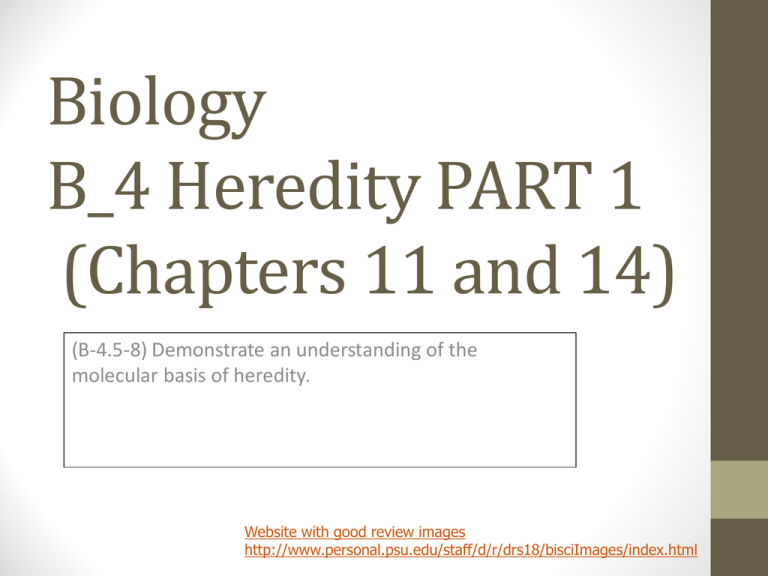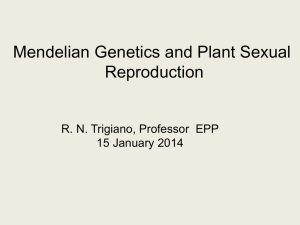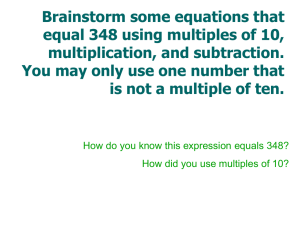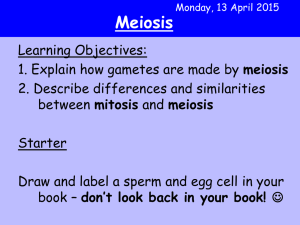
Biology
B_4 Heredity PART 1
(Chapters 11 and 14)
(B-4.5-8) Demonstrate an understanding of the
molecular basis of heredity.
Website with good review images
http://www.personal.psu.edu/staff/d/r/drs18/bisciImages/index.html
B-4.5 Meiosis (sec 11-4)
• What is DIPLOID and HAPLOID?
• What is the chromosome # in somatic cells & gametes?
• What is the function of Meiosis?
• What happens in interphase?
• What happens in Meiosis I?
• List stages; Crossing over; Anaphase I
• What happens in Meiosis II?
• How does gamete production differ in males &
females?
Explain Chromosome # in
somatic cells & gametes
SOMATIC CELLS (body cells)
• DIPLOID (2N) cells which Contains 2 sets
(N) of chromosomes (double);
• TWO alleles (copies) of each gene
GAMETES (sex cells)
• HAPLOID (N) Contains ONE set of
chromosomes (Half of body cells);
• ONE allele (copy) of each gene
• Egg (1 copy of mother’s DNA)
• Sperm (1 copy of father’s DNA)
VOCABULARY
GENE –section of
DNA codes for
trait.
EX: Height
ALLELE - different
version of a gene
(trait)
EX: Tall or Short
Examples: Diploid vs Haploid
Fruit Flies
• Diploid (2N) = 8 (body cells)
N = set of chromosomes
2N = 2 sets of chromosomes
• Haploid (N) = 4 (gametes)
Humans
• Diploid (2N) = 46 (body cells)
• Haploid (N) = 23 (gametes)
Mitosis division makes identical diploid cells– repair, growth, and
development (begins shortly after fertilization and ongoing)
• BODY CELL (diploid) divides once to make more BODY CELLS (diploid)
• ACTIVITY – All cells arise from pre-existing cells: http://dnaftb.org/7/
So how are gametes (egg/sperm) made if they have half the
chromosomes of a body cell???
• ACTIVITY – Sex cells have one set of chromosomes; body cells have
two: http://dnaftb.org/8/
What process produces gametes
(egg/sperm)? ____MEIOSIS___
MEIOSIS: Cuts Chromosome # in HALF /(2N N) 46 23
• Interphase
• DNA is replicated (46 doubled to 92)
• Instead of 2 copies of every gene there are now 4 copies
• Meiosis I – begins w/ 1 diploid cell(92) ends w/ 2 haploid cells
• CROSSING OVER occurs genes swapped/causes variety in
gametes
• HOMOLOGOUS pairs (similar chromosomes) are Separated
• Meiosis II - begins w/ 2 haploid cells (46) ends w/ 4 haploid
gametes (23)
• Phases work the same as mitosis
• Anaphase II - chromosomes separated at centromere
http://staff.jccc.net/PDECELL/celldivision/chromosome1.gif
Chromosomes
DNA during cell division
Chromatids joined by centromere
Humans cells have total
(23 pairs)
REVIEW:
Chromosome
Structure
http://avonapbio.pbworks.com/f/chromosome.bmp
Homologous
Chromosomes
http://staff.jccc.net/PDECELL/celldivision/chromoterm.html
course1.winona.edu
http://theano5.blogspot.com/
1st DIVISION - Meiosis I
Interphase I
Dna is doubled
Prophase I
Metaphase I
Anaphase I
Prophase I
(92)
Chromosomes arrange in Homologous pairs; Crossing
over occurs – pairs swap alleles making new
combinations
Metaphase I
Homologous pairs line up at middle
Anaphase I
Homologous PAIRS are split apart
Telophase I
(46)
2 nuclei with 46 chromosomes each followed by
cytokinesis (2 cells)
2nd DIVISION - Meiosis II (similar to mitosis)
Prophase II
Metaphase II
Anaphase II
Prophase II
chromosomes prepare to divide
Metaphase II
Chromosomes meet at middle
Anaphase II
Sister chromatids are split apart
Telophase II
4 haploid gametes (23 chromosomes)
Followed by cytokinesis
Telophase II
http://www.cix.co.uk/~argus/Dreambio/cell%20division/meiosis%20animation.gif
Explain Crossing Over..
• Increases genetic variation in gametes (causes variety in offspring)
Doubled
HOMOLOGOUS PAIR
(tetrad)
A,Bbrown eyes
C,D,Ebrown hair
Mom’s
Each chromatid will
Be passed on to diff.
gamete
a,bblue eyes
c,d,eblonde hair
Dad’s
Chromatids trade alleles
Creates 4 different
combinations
Gamete
Production
• In males —
spermatogenesis
produces 4 haploid
sperm
• In females —
oogenesis produces
1 haploid egg
(ovum), 3 polar
bodies
•http://www.classzone.com/cz/books/bio_07/resources/htmls/ani
mated_biology/unit3/bio_ch06_0175_ab_meiosis.html
46XY
23 X
23 X
23 Y
46XX
23 X
23 Y
Mitosis
Growth/Development
Asexual reproduction
Meiosis
Egg and Sperm
Sexual Reproduction
Start: 1 Diploid Cell (2N)
Start: 1 Diploid Cell (2N)
Cell Divides Once
Cell Divides Twice
Crossing over makes new
combination of alleles
End: 2 Diploid Cells (2N)
Body cells – skin, muscle
New cells are genetically
IDENTICAL
End: 4 Haploid Cells (N)
Gametes – egg, sperm
New cells are genetically
DIFFERENT from each other &
parent
http://users.rcn.com/rpohlman/comparison.gif
B-4.6 Mendelian Genetics(sec 11-1,2,3)
Use Mendel’s laws to predict
inherited traits
Summarize Mendel’s experiment.
Hypothesis – Variables (IV & DV) - Conclusion
Law of Segregation states…
Principle of Dominance states…
How are dominant and recessive traits shown?
Relationship between Genotype and Phenotype.
Practice Probability & Monohybrid Crosses
Law of independent assortment states…
How does that differ from the law of segregation?
Practice Dihybrid Crosses
Intro to GENETICS…
• GENETICS is the study of heredity…
• (passing of traits from one generation to the next)
• GREGOR MENDEL (an Austrian Monk) 1852
• Performed experiments using pea plants and which where
the basis for understanding genetics.
• Mendel’s LAW explains how GENES are passed from one
generation to the next
• ACTIVITY – Children resemble their parents:
http://dnaftb.org/1/
• WALTER SUTTON 1902
• Developed the Chromosome Theory of Heredity… states
that GENES are located on CHROMOSOMES
Mendel’s Experiment:
• PROBLEM:
• How are traits passed from one generation to the next?
• HYPOTHESIS:
• If then P generation had different traits, then the F1
generation would be a MIX of both parents.
• PROCEDURE: (pea plant experiments)
• P (parents) = Tall plant X Short plant (cross pollination to
produce hybrids)
• F1 = offspring; predicted to be all Medium Height
• F1 = 1st generation offspring & F2 = 2nd generation offspring)
• TRIALS = He studied 7 traits (height, color, shape, etc…)
Cross-Pollination
Mendel’s RESULTS
• P cross = Tall X Short
• F1 generation = All Tall
• F1 cross = Tall X Tall
• F2 generation = 3 Tall, 1 Short (3:1)
P Generation
F1
F2
Section 11-1
Go to
Section:
Mendel’s Seven F1
Crosses on Pea Plants
Seed Coat
Color
Pod
Shape
Pod
Color
Smooth
Green
Seed
Shape
Seed
Color
Round
Yellow
Gray
Wrinkled
Green
White
Constricted
Round
Yellow
Gray
Smooth
Flower
Position
Plant
Height
Axial
Tall
Yellow
Terminal
Short
Green
Axial
Tall
Conclusions and
Law of Segregation
• ACTIVITY – Genes come in pairs: http://dnaftb.org/2/
• ACTIVITY – Some genes are dominant: http://dnaftb.org/4/
• Traits are inherited as separate units (genes) which are not
blended.
• Gene section of DNA, codes for trait…
• Ex: such as Height
• Allele: different form (version) of a gene…
• Ex: such as Tall / Short
• LAW OF SEGREGATION:
• Organisms inherit 2 copies of each gene; 1 from each
parent.
• Organisms donate only 1 copy of each gene in their
gametes (egg or sperm) during meiosis
Principle (law) of DOMINANCE
Alleles can be either…
• DOMINANT… written in UPPER CASE
• recessive… written in lower case (same letter)
• EX: Gene = Height
• Alleles = T (tall), t (short)
• Organism inherit 2 alleles for each gene…
• If organism has a Dominant allele, it will show Dominant
trait (TT or Tt = tall)
• If dominant is not present then RECESSIVE trait is shown (tt
= short)
Relationship Between
Genotype & Phenotype
• GENOTYPE – genetic make up (the alleles) of
organism (EX: Tt, GG)
• HOMOZYGOUS – has same alleles, purebred (EX: tt, TT, gg, GG)
• HETEROZYGOUS – has different alleles, hybrid (EX: Tt, Gg)
• PHENOTYPE – physical make up (traits shown by
alleles) of organism (EX: tall, yellow)
Law of Independent Assortment
• Review – Law of Segregation:
• aka separation of genes
• Organisms donate 1 copy of each gene
Law of Independent Assortment:
• During meiosis…Traits are inherited separately – causing
different combination of traits (Tall, yellow plants; Short,
yellow plants)
• Traits do NOT influence the inheritance of other traits
• Color of plant does not affect height
• Attached earlobes does not affect freckles
Probability & Genetic Crosses
• ACTIVITY – Genetic inheritance follows rules: http://dnaftb.org/5/
• PROBABILTY is the likely hood that an event will occur
(prediction)
• In reality you don’t get the EXACT ratio of results shown in the
square. This is because genetics is kind of like flipping a coin (each
time you flip it you have a 50:50 chance of getting heads).
• PUNNETT SQUARES use probability to quickly predict possible
outcomes of a genetic cross In 1905, Reginald Punnett, devised
a shorthand way of finding the expected possible offspring
genotypes.
• MONOHYBRID
• Predict all possible outcomes of how 1 trait will be inherited
• DIHYBRID
• Predict all possible outcomes of how 2 traits will be inherited
http://kmbiology.weebly.com/mendel-andgenetics---notes.html
Monohybrid Cross
RATIOS:
• Genotypic = TT :Tt: tt
• Phenotypic = Tall : Short
(always in this order)
tt (parent)
TT (parent)
T
(sperm)
t
(egg)
t
(egg)
T
(sperm)
Monohybrid Cross
• Uses Punnett Squares to see POSSIBLE result
of how ONE GENE (trait) is passed on…
• TT X tt
TT (parent)
(Homozygous tall) X (Homozygous short)
RATIOS:
• Genotypic = 0:4:0
• TT :Tt: tt
• Phenotypic = 4:0
• Tall : Short
(always in this order)
tt (parent)
T
(sperm)
T
(sperm)
t
(egg)
Tt
Tt
t
(egg)
Tt
Tt
G
G
g
g
T
T
t
t
Results
• Genotypic Ratio =
______:_____:_____
• Phenotypic Ratio =
_____:_____
Results
• Genotypic Ratio =
____:____:____
• Phenotypic Ratio =
_____:____
g
G
G
Gg
Gg
(green)
g
(green)
Gg
Gg
(green)
T
T
t
TT
Tt
Tt
tt
(tall)
t
(green)
(tall)
(tall)
(short)
Results
• Genotypic Ratio = 0:4:0
(GG:Gg:gg)
• Phenotypic Ratio 4 :0
• (green):0 (yellow)
Results
• Genotypic Ratio =
1:2:1 (TT:Tt:tt)
• Phenotypic Ratio 3 :1
• (tall): 1 (short)
Test Cross
• A test cross is a way
to determine the
genotype of an
organism with an
unknown genotype.
• Cross unknown with
known.
• http://kmbiology.weebly.com/test-cross--notes.html
Dihybrid Crosses
Possible combination of how TWO Genes are inherited.
• Size of Punnett Square is 4 X 4
• Each Gene is inherited Independent of other (law of
independent assortment)
• EX: Height and Color
Tall yellow (TTYY) X short green (ttyy)
List the possible allele combination that
could be in a gamete (egg or sperm)
Gamete possibilities
TTYY
1. __TY___
2. __TY____
3. __TY____
4. __TY____
ttyy
1. __ty___
2. __ty____
3. __ty____
4. __ty____
TY
TY
TY
TY
ty
ty
ty
ty
Try this TWO Factor Cross of P generation (TTYY) x (ttyy)
TY
TY
TY
TY
ty
TtYy
TtYy
TtYy
TtYy
ty
TtYy
TtYy
TtYy
TtYy
ty
TtYy
TtYy
TtYy
TtYy
TtYy
TtYy
TtYy
TtYy
ty
What are the possible phenotypes? genotypes
List the possible allele combination that
could be in a gamete (egg or sperm)
TtYy
1. __TY___
2. __Ty____
3. __tY____
4. __ty____
TtYy
1. __TY___
2. __Ty____
3. __tY____
4. __ty____
TY
TY
Ty
tY
ty
Ty
tY
ty
What are the possible phenotypes? Genotypes?
TY
TY
Ty
tY
ty
Ty
tY
ty
TTYY TTyY tTYY
tTyY
(tall, yellow)
(tall, yellow)
(tall, yellow)
TTYy
TTyy tTYy
tTyy
(tall, yellow)
(tall, green)
(tall, green)
TtYY
TtyY ttYY
(tall, yellow)
(tall, yellow)
(short, yellow) (short, yellow)
TtYy
Ttyy
ttYy
(tall, yellow)
(tall, green)
(short, yellow) (short, green)
(tall, yellow)
(tall, yellow)
ttyY
ttyy









